Families fight for families
by D.E. Bentley –
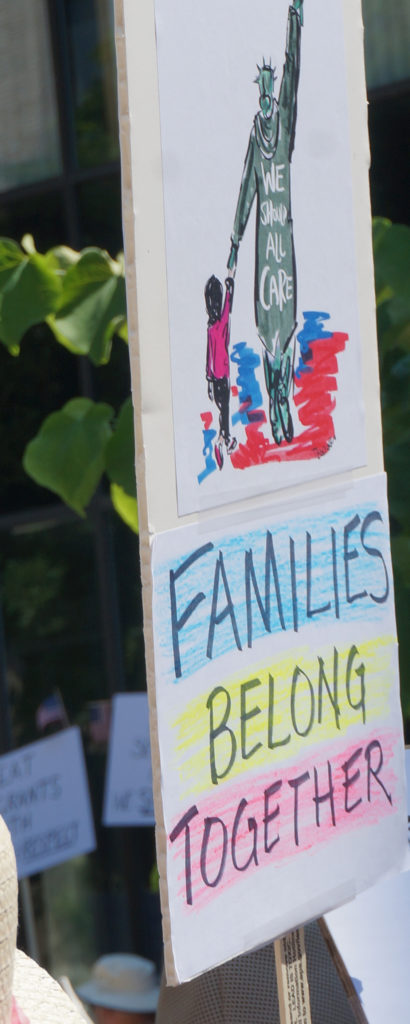
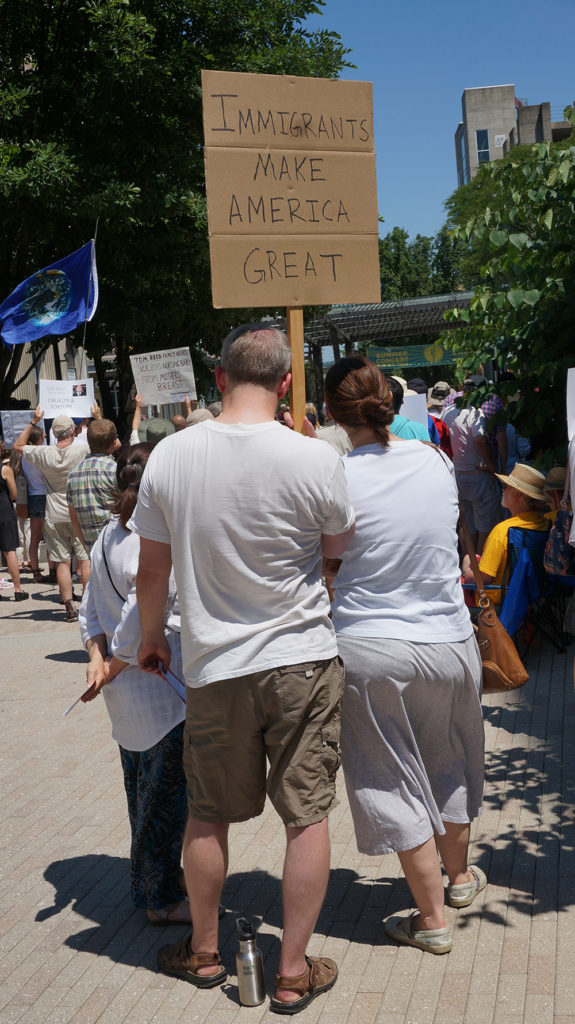 On June 30, 2018, I joined hundreds of people gathered on the Commons in Ithaca, NY. The Ithaca area Families Belong Together* rally was one of six hundred or more protests that took place across the United States, including numerous other events across the Finger Lakes region. As I passed through Geneva on my way to Ithaca, Lakefront Park was already buzzing with activity and c
On June 30, 2018, I joined hundreds of people gathered on the Commons in Ithaca, NY. The Ithaca area Families Belong Together* rally was one of six hundred or more protests that took place across the United States, including numerous other events across the Finger Lakes region. As I passed through Geneva on my way to Ithaca, Lakefront Park was already buzzing with activity and c
ars were being directed into a large, rapidly filling lawn area. Despite the heat, it looked to be a large turnout there. The Geneva Families Belong Together event followed earlier protests in the city – held at the office of Congressman Tom Reed – calling for Reed to advocate for the immediate reuniting of separated children with their parents.
Although the Administration has already faced criticism for their response to individuals and groups concerned about human rightsviolations, policy decisions that allowed in recent months children to be taken from their parents, as well as escalated “zero tolerance” deportation actions that are separating families, are the primary factors driving recent protests. A policy reversal on the part of the Trump administration, and a resulting mandate by San Diego region U.S. District Judge Dana M. Sabraw to reunite more than 2300 detained children with their families – those four and under by July 10th and those between the ages of 5 and 17 by July 26th – was followed by a request from the Trump administration for additional time for family unification. On July 9th Judge Sabraw granted Trump’s request, although a LosAngeles judge denied the administration’s request to detain child migrants for longer than the currently allowable 20 days. In a time when governments around the world are issuing public apologies for stolen and lost children, it is unfathomable that the United States would mandate the removal of children from parents and then lose track of who belongs to who, yet it appears that that is what has happened. Trump administration authorization to use DNA to reunite families has also received criticism from migrant support advocates, amid concerns that the administration could use the data they collect from the DNA tests to track migrant families.
Children remain the most vulnerable of the roughly 11 million unauthorized individuals currently living in the US. Equally vulnerable are US born (citizen) children of undocumented migrants. These children face the loss of those they love and depend on for emotional and financial support. Not surprisingly, children, families, were well represented in Ithaca, and at protests across the country. Ithaca, situated on the northern tip of Cayuga Lake and home of Cornell University and Ithaca College, is a diverse city that offers hometown returnees, like myself, and visitors alike a rich reminder that we are a country defined not by nationalistic exclusion, but, rather, by the richness inherent in our social and cultural diversity as a nation – and our commitment to an expanding vision of equality and inclusion. The Commons in front of the Bernie Milton Pavilion (Miss you Bernie!) was filled with mingling crowds – drawn together in solidarity.
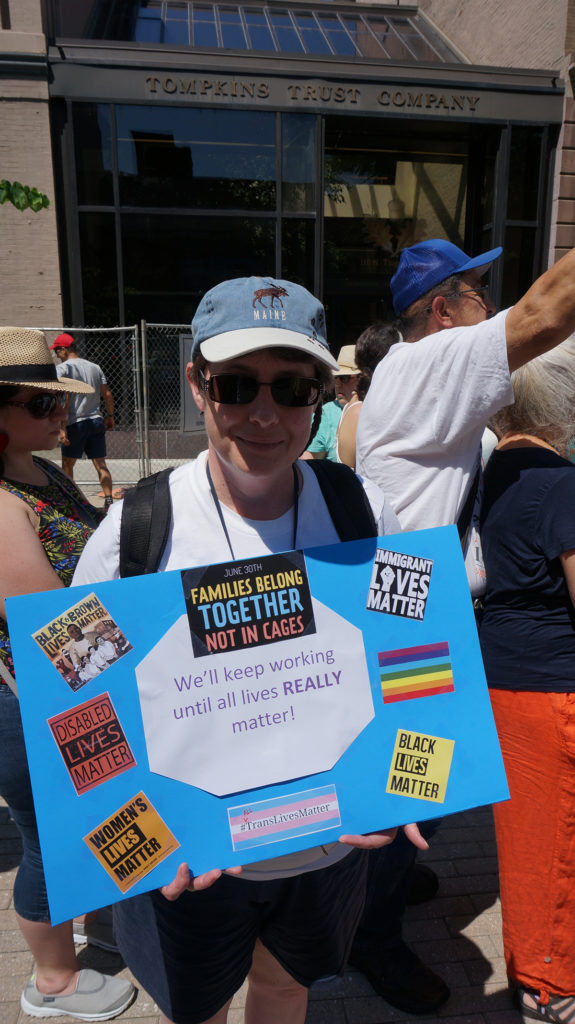
One attendee at the Ithaca rally, Diana Katovitch, Coordinator of Syracuse University’s Peer to Peer Program and Assistant Director of The Taishoff Center (dedicated to providing full and equitable participation of students with disabilities in higher education, especially students who have traditionally been excluded from post-secondary education), shared a succinct perspective on why she needed to be present. “This is not who we are; a hundred years ago this was my family.” Like many of those present, she carried a sign – what first caught my attention in the crowd – and like many present, she recognizes that these recent actions on the part of our government are not unique to our history as a nation. “For all of the marginalized groups I listed on my sign, it [abuse and injustice] has been a reality. We can do better than this. We know it’s wrong; now, we have to act like we mean it. “
The signs that sprouted up from the crowds and from beneath shaded building overhangs in the sweltering summer heat were the beacons that pulled me toward particular areas of the crowd, as families and representatives from many different ethnic, religious and humanitarian groups assembled side-by-side in solidarity of those impacted by recent policy actions. Many signs called for families to be reunited and for an end to indiscriminate zero-tolerance immigration policies that harm families. A few played on current memes – there were a number that touched on Melania Trump’s “I really don’t care, do U?” apparel choice. Some just offered reminders about America’s founding – Immigrants make America Great” – and our need to be more accepting and unifying as a nation and world – “We are One.” Still others called for a reboot of the current immigration system. There were a number of signs calling for the abolishment of ICE. Immigration and Customs Enforcement (ICE) is an agency created in 2003, in the wake of 9-11 as part of the Homeland Security Agency. They are not the agency responsible for the recent separation of parents and children at the border – that falls under the jurisdiction of Customs and Border Protection. However, the Enforcement and Removal Operations leg of ICE arrests, detains and deports unauthorized immigrants already inside the United States.

We are fighting for our reunification.
Unlike President Barack Obama’s administration, which prioritized removing undocumented immigrants who had committed serious crimes in the United States while seeking pathways for legitimacy and citizenship for other undocumented migrant residents, Mr. Trump’s zero tolerance tactics target anyone in the country illegally (ands some here legally). This despite compelling data from the Pew Research Center that shows a drop in the number of unauthorized immigrants in the US between 2009 and 2015 (3.4 % of the total US population in 2015) during Obama’s presidency. Most of those potentially facing deportation are established members of American
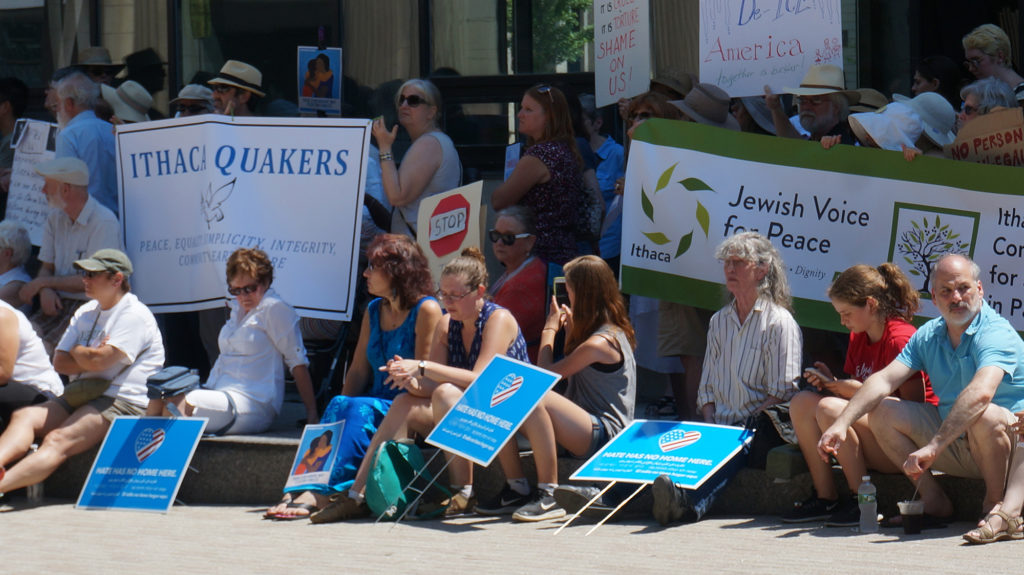
society, and contributing members of the communities in which they live. According to the non-partisan Migration Policy Institute, about 60% of the unauthorized population has been here for at least a decade. Almost one-third owns their homes. Further, a third of undocumented immigrants over the age of fifteen live with one or more children who are US citizens. Detaining and deporting individuals who have not committed violent crimes, critics argue, hurts children (including US citizens). It increases family stress
due to the loss of wage earners (and tax payers). An increased fear of detainment and deportation also disrupts the education of children. There have already been reported drops in school attendance in districts with high numbers of immigrant families as a result of recent administrative policies and actions. The potential harm to children and families and the shift toward deportation of all unauthorized persons rather than those who have committed serious crimes has fueled these recent calls to abolish ICE.
One “Abolish ICE” sign caught my attention for a different reason. I noticed that the sign holder, Jesse Brown, was standing in front of a chain link fence – cordoning off a construction zone. I could not help but equate this fence with the type of confinement areas that “house” people trying to cross borders to escape violence and forge a better future for themselves and their children. For Brown, “abolishing ICE would be a start.” He stated that, “eliminating immigration restrictions would balance the economic injustice and other factors that cause people to move to begin with.” Adding that governments and corporations are “fine with border crossing to exploit others, but not to provide people with protection.” When I asked if he thought eliminating immigration restrictions would result in too many people in some places, he responded without hesitation, “ No one wants to leave their home.” There are critics of opening borders who would argue otherwise, but Brown’s sentiment underscores the need to place more emphasis on problem solving diplomacy, and on providing for all peoples, everywhere, so that homelands do not become uninhabitable war zones and wastelands.
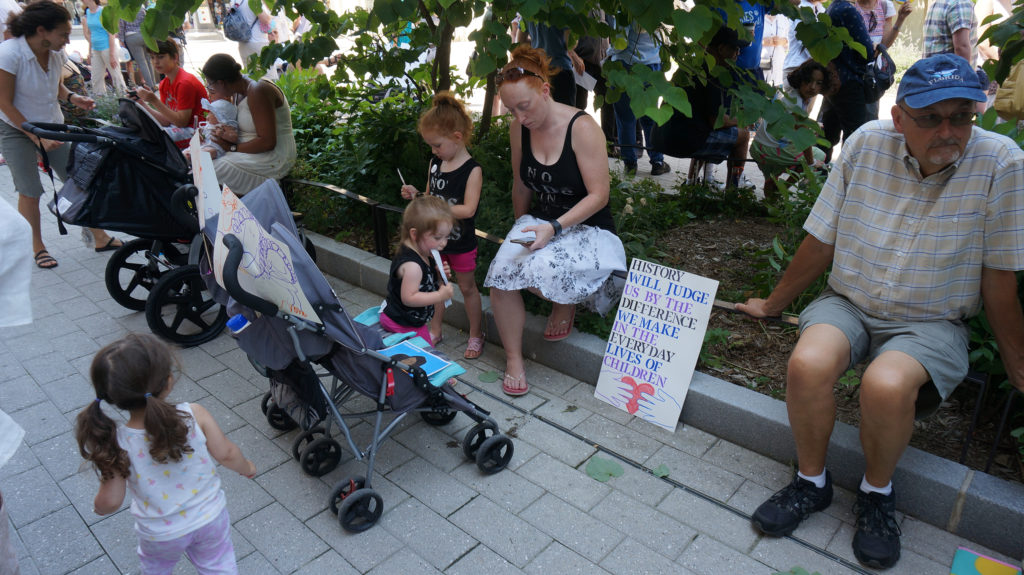
Concerns for the welfare of children remained central to the Ithaca rally, and I saw many family groups with individuals of all ages joining together in solidarity, and protest. Janice O’Connell, from Dexter, NY, had come out with her daughters, Cora (age 4) and Alice (age 2), both of whom, along with mom, wore “No kids in cages” shirts. Ms. O’Connell said that she spent time before the event talking with her children, especially four-year-old Cora, about the US policy that allowed for family separation. We had some pretty solid conversations about what was happening, and why. Cora asked a lot of questions, and decided that she would like to help me make the signs, because she wanted everyone to know that the kids needed their mommies and daddies back.” Cora’s artwork is on the back of the girls’ signs.
On a Facebook post in advance of the rally, Janice O’Connell shared an experience that touches on the loss felt by separated families and brings home why she (and so many other parent attendees) believed it was important to join in the Families Belong Together protests.
“My older daughter, completely contrary to her usual cautious personality, wandered off at a public place recently. She was only missing for a minute, but my world stopped. She was thankfully old enough to find a helper, explain she was lost, and give her name and mine. We were reunited quickly, and we both cried when we found each other. My younger daughter is so little that if she were ever separated from me, she wouldn’t be able to do that. Losing a child even for a minute is scary. I can’t imagine the terror of uprooting your family in a desperate attempt to keep your children safe, only to have them torn from your arms, with no way to contact them, and without knowing if you will ever see them again.
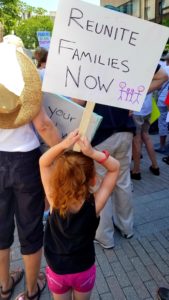
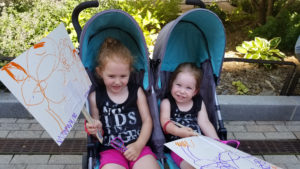
My daughters and I will protest on Saturday because no parent, and no child, should experience what is happening. We will protest because locking up entire families indefinitely is not an acceptable solution. We will protest because the families that have been separated need to be reunited. We will protest because we have the right and the privilege to be able to do so. And I will protest because I need my daughters to know, even at their “tender age”, that when there is wrong in the world, it is their responsibility to take a stand.”
There were children everywhere at the Ithaca event, accompanied by their parents. They played happily in the sunshine, enjoying their time out, their time with their families. Seeing this and hearing immigrant children’s stories replayed on newsreels reminded me of an experience I had, similar to O’Connell’s shared story. When my son, now 26, was quite young we were in a very crowded space, taking care of a transaction at a counter, and he wandered away. All reacted immediately and we quickly found him – staring up at a large TV screen – but those moments, the feeling of loss of that time apart made it seem much longer. Having your children taken away, not knowing when you will see them again when your only “crime” is to seek out a better life for them, is an unimaginable horror. It was impossible to see these children and not think of the losses these families are suffering, only to again be returned to circumstances dire enough to drive them to extremes.
This past Thursday I spent an enjoyable and relaxing afternoon with some friends and their three young children. I could not begin to image the emotional turmoil and grief they all would feel if they were forcibly separated – children taken away crying – even if only for a short period of time. That we, as a nation constructed from the sweat and toil and imaginations of peoples from across the oceans and all around the world, could disregard adversity and diversity – for what gain, I am not sure – has me questioning, once again, the greatness we so adamantly cling to as a defining feature of our national identity. In returning to Ithaca, in seeing so many people taking a stance for what is right and just, I know that it is not the actions of a few that make US truly great, but the collective voices, and actions, of the people – and the slow, ever turning, wheels of change that have, and continue, to define who we are.